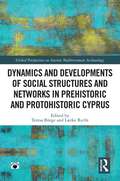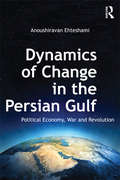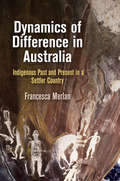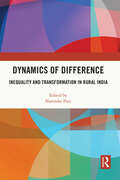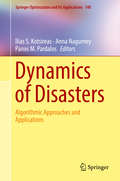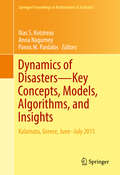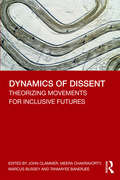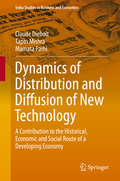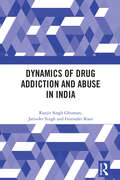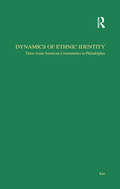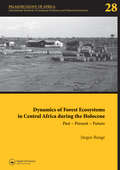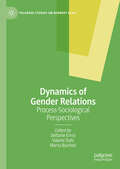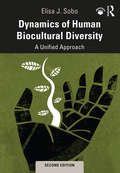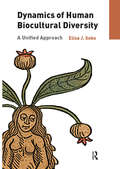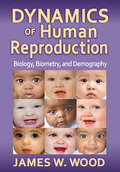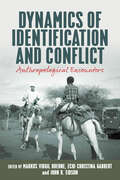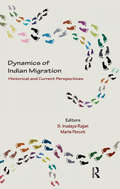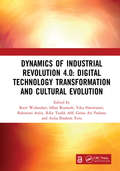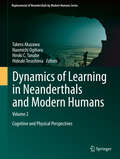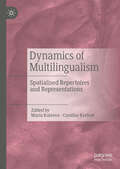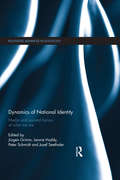- Table View
- List View
Dynamics and Developments of Social Structures and Networks in Prehistoric and Protohistoric Cyprus (Global Perspectives on Ancient Mediterranean Archaeology)
by Teresa Bürge Lærke RechtThis volume substantiates the island of Cyprus as an important player in the history of the ancient Eastern Mediterranean and Near East, and presents new theoretical and analytical approaches. The Cypriot Neolithic, Chalcolithic, and Bronze Age are characterised by an increasing complexity of social and political organisation, economic systems and networks. The book discusses and defines how specific types of material datasets and assemblages, such as architecture, artefacts, and ecofacts, and their contextualisation can form the basis of interpretative models of social structures and networks in ancient Cyprus. This is explored through four main themes: approaches to social dynamics; social and economic networks and connectivity; adaptability and agency; and social dynamics and inequality. The variety and transition of social structures on the island are discussed on multiple scales, from the local and relatively short-term to island-wide and eastern Mediterranean-wide and the longue durée. The focus of study ranges from urban to non-urban contexts, and are reflected in settlement, funerary, and other ritual contexts. Connections, both within the island and to the broader Eastern Mediterranean, and how these impact social and economic developments on the island, are explored. Discussions revolve around the potential of consolidating the models based on specialised studies into a cohesive interpretation of society on ancient Cyprus and its strategic connections with surrounding regions in a diachronic perspective from the Neolithic through the end of the Bronze Age, i.e. from roughly the seventh millennium to the eleventh century BCE. Prehistoric and Protohistoric Cyprus is intended for researchers and students of the archaeology and history of ancient Cyprus, the Aegean, and the Eastern Mediterranean.
Dynamics and Performativity of Imagination: The Image between the Visible and the Invisible (Routledge Research In Cultural And Media Studies #21)
by Christoph Wulf Bernd HuppaufIn this interdisciplinary anthology, essays study the relationship between the imagination and images both material and mental. Through case studies on a diverse array of topics including photography, film, sports, theater, and anthropology, contributors focus on the role of the creative imagination in seeing and producing images and the imaginary.
Dynamics of Change in the Persian Gulf: Political Economy, War and Revolution
by Anoushiravan EhteshamiThe Persian Gulf has come to represent one of the most strategically significant waterways of the world. In terms of geography, geopolitics, resources, global political economy, and regional influence, the Gulf is perhaps home to the world’s most significant group of countries. Focusing on the complexities of the interplay between domestic-level changes and region-wide interactions, this book presents the reader with the first comprehensive survey of the dynamics of change in this crucial area. Systemic-oriented in its approach, the impact of war and revolution on the countries of the sub-region is discussed, and the ways in which these factors have shaped the security dilemmas and responses of the Gulf States is also explored. The role of oil is examined in terms of the impact of its income on these states and societies, and the manner in which oil has shaped the integration of these states into the global system. Oil has shrunk developmental time in these countries, and has accelerated generational shift. At the same time, it has created the dialectical relationship which now characterizes the difficult balance between prosperity and instability which is at the heart of the sub-region. Casting new light on the workings of a strategically significant part of the international system, this book will be an essential resource for students and scholars of international relations, international security and Middle Eastern politics.
Dynamics of Difference in Australia: Indigenous Past and Present in a Settler Country
by Francesca MerlanIn Dynamics of Difference in Australia, Francesca Merlan examines relations between indigenous and nonindigenous people from the events of early exploration and colonial endeavors to the present day. From face-to-face interactions to national and geopolitical affairs, the book illuminates the dimensions of difference that are revealed by these encounters: what indigenous and nonindigenous people pay attention to, what they value, what preconceived notions each possesses, and what their responses are to the Other. Basing her analysis on her extensive fieldwork in northern Australia, Merlan highlights the asymmetries in the exchanges between the settler majority and the indigenous minority, looking at everything from forms of violence and material transactions, to indigenous involvement in resource development, to governmental intervention in indigenous affairs.Merlan frames the book within the current debate in Australian society concerning the constitutional recognition of indigenous people by the nation-state. Surveying the precursors to this question and its continuing and unresolved nature, she chronicles the ways in which an indigenous minority can remain culturally different while simultaneously experiencing the transformative forces of domination, constraint, and inequality. Conducting an investigation of long-term change against the backdrop of a highly salient and timely public debate surrounding indigenous issues, Dynamics of Difference has far-reaching implications both for public policy and for current theoretical debates about the nature of sociocultural continuity and change.
Dynamics of Difference: Inequality and Transformation in Rural India
by Narendar PaniThis original conceptualization provides insights into the role of inequality in the processes of change in rural India. It presents in-depth analyses and understanding of the nature and form of inequality, and its causes and consequences. The volume examines interpersonal, intergroup, and intrapersonal inequalities in the country’s rural transformation. Through research based on ethnographic, primary survey and secondary data methods, this multidimensional study discusses key themes such as normative and descriptive inequalities; class, caste and other identities; economic poverty; educational poverty; poverty in health; gendered poverty; inequality and power; the impact of migration; ethical issues and vulnerabilities; and suicidal consequences of inequality. It builds cohesive arguments, based on the development of several new indicators, to examine rural inequality. This book will be of interest to scholars and researchers of political economy, economics, development studies, development economics, sociology, public policy, political science, political sociology, and rural sociology.
Dynamics of Disasters: Kalamata, Greece, June-july 2015 (Springer Proceedings in Mathematics & Statistics #185)
by Panos M. Pardalos Ilias S. Kotsireas Anna NagurneyThis book surveys new algorithmic approaches and applications to natural and man-made disasters such as oil spills, hurricanes, earthquakes and wildfires. Based on the “Third International Conference on Dynamics of Disasters” held in Kalamata, Greece, July 2017, this Work includes contributions in evacuation logistics, disaster communications between first responders, disaster relief, and a case study on humanitarian logistics. Multi-disciplinary theories, tools, techniques and methodologies are linked with disasters from mitigation and preparedness to response and recovery. The interdisciplinary approach to problems in economics, optimization, government, management, business, humanities, engineering, medicine, mathematics, computer science, behavioral studies, emergency services, and environmental studies will engage readers from a wide variety of fields and backgrounds.
Dynamics of Disasters—Key Concepts, Models, Algorithms, and Insights
by Panos M. Pardalos Ilias S. Kotsireas Anna NagurneyThis volume results from the "Second International Conference on Dynamics of Disasters" held in Kalamata, Greece, June 29-July 2, 2015. The conference covered particular topics involved in natural and man-made disasters such as war, chemical spills, and wildfires. Papers in this volume examine the finer points of disasters through: Critical infrastructure protection Resiliency Humanitarian logistic Relief supply chains Cooperative game theory Dynamical systems Decision making under risk and uncertainty Spread of diseases Contagion Funding for disaster relief Tools for emergency preparedness Response, and risk mitigation Multi-disciplinary theories, tools, techniques and methodologies are linked with disasters from mitigation and preparedness to response and recovery. The interdisciplinary approach to problems in economics, optimization, government, management, business, humanities, engineering, medicine, mathematics, computer science, behavioral studies, emergency services, and environmental studies will engage readers from a wide variety of fields and backgrounds.
Dynamics of Dissent: Theorizing Movements for Inclusive Futures
by John Clammer Meera Chakravorty Marcus Bussey Tanmayee BanerjeeThis book analyses dissent and its manifestations in movements of social and political transformation across communities and cultures. It shows how these movements create ruptures in the structures of power, and social hierarchy; expressed through songs, slogans, poetry and performances. The chapters in the book explore these sites of transgression and the imprint they leave on culture, politics, beliefs and the collective society – via music and poetry as in the Bhakti movement or through feministic theories born in post-World War Europe. It also explores how these dynamic movements generate alternate spaces within which the self, identity and collective purpose take new forms and find new meanings as they travel. This book will be of interest to students and scholars of the humanities, literature, history, sociology, politics and culture studies.
Dynamics of Distribution and Diffusion of New Technology
by Claude Diebolt Tapas Mishra Mamata ParhiThis book presents a comprehensive study of adoption and diffusion of technology in developing countries in a historical perspective. Combining the development of growth trajectories of the Indian economy in general and its manufacturing industry in particular, the book highlights the effective marriage between qualitative and quantitative methods for a better understanding and explaining of many hidden dynamic behaviors of adoption and diffusion trend in manufacturing industry. The use of various econometric methods is aimed to equip readers to make a judgement of the current state of diffusion pattern of new technologies in India and simulate a desirable future pattern in view of the various pro-industrial growth policies.
Dynamics of Drug Addiction and Abuse in India
by Jatinder Singh Ranjit Singh Ghuman Gurinder KaurThis book analyzes drug addiction and abuse from the perspectives of the state and community in India, with a special focus on North-West regions of India. India lies in the transit route of two major global centres of heroin and cocaine processing: the Golden Triangle of Myanmar, Thailand and Laos towards the East; and the Golden Crescent of Afghanistan, Iran and Pakistan to the West making it vulnerable to drug trafficking and curbing this has been a tough challenge for enforcement agencies. The book looks at: the nature and pattern of drug addiction across the age groups, gender and occupational groups, both in rural and urban areas in India; the socio-economic causes of drug-use and addiction and the various socio-economic costs associated with it; the general perception of family members, police and political leaders on drug addiction as well as rehabilitation; and available mechanisms to address the issue at the level of family, society and government and the changes required in policy to curb drug addiction and use This interdisciplinary book will be of importance to students and researchers of economics, cultural and social anthropology, sociology, police administration, political science, and psychology. It will also be of interest to policy makers, government agencies, social scientists, departments of social and preventive medicine, social workers, civil society, drug-addicts and their families.
Dynamics of Emigration: Émigré Scholars and the Production of Historical Knowledge in the 20th Century (Making Sense of History #43)
by Stefan Berger and Philipp MüllerAs a pioneering volume to consider the impact of exile on historical scholarship in the twentieth century in a systematic and global way, looking at Europe, North America, South America and Asia, Dynamics of Emigration asks about epistemic repercussions on the experience of exile and exiles. Analyzing both the impact that exile scholars had on their host societies and on the societies they had to leave, the volume investigates exiles’ pathways to integration into new host societies and the many difficulties they face establishing themselves in new surroundings. Focusing on the age of extremes and the realms of exile from fascist and right-wing dictatorships as well as communist regimes, the contributions look at the reasons scholars have for going into exile while providing side-by-side examination of the support organizations and paths for success involved with living in exile.
Dynamics of Ethnic Identity: Three Asian American Communities in Philadelphia (Studies in Asian Americans)
by Jae-Hyup LeeThis comparative study of the Chinese, Korean, and Vietnamese American communities in Philadelphia shows that each Asian American community maintains its own internal cultural boundaries, which are used to cultivate differences that become institutionalized over time. Socially constructed boundaries, such as ethnicity, gender, class and generation, intersect within and among ethnic groups. Based on a social anthropological framework, this study describes the mechanism of ethnic and class identity formations, and shows how identities are institutionalized through various organizations. By unraveling the complexity of Asian American communities and their boundary strategies, this study provides a look at the new political processes which Asian Americans are creating in a variety of social settings. Also includes maps. (Ph.D. dissertation, University of Pennsylvania, 1994; revised with new preface, introduction)
Dynamics of Family and Intimate Partner Violence
by Christina E. Newhill Irene Hanson Frieze Rachel FuscoThis book provides a research-based analysis of the dynamics of several types of violence in families and close relationships, as well as a discussion of theories relating to the experiences of victims. Drawing on recent research data and case studies from their own clinical experiences, the authors examine causes, experiences, and interventions related to violence in various forms of relationships including children, elders, and dating or married couples.Among the topics covered:Causal factors in aggression and violenceTheories of survivor coping and reactions to victimizationInterventions for abused women and childrenOther forms of family violence: elder abuse, sibling abuse, and animal crueltySocietal responses to abuse in the familyDynamics of Family and Intimate Partner Violence is a crucial resource for practitioners and students in the fields of psychology and social work, vividly tying together theory and real-life case studies.
Dynamics of Forest Ecosystems in Central Africa During the Holocene: Palaeoecology of Africa, An International Yearbook of Landscape Evolution and Palaeoenvironments, Volume 28 (Palaeoecology of Africa)
by Jürgen RungeBringing together experts from several disciplines, this volume collects the best papers presented at the international workshop on 'Environmental and Cultural Change in West and Central Africa, held in Cameroon, March 2006. Problems of Holocene and Late Pleistocene modifications of the rain forest savanna fringe and their possible influence on cultural innovations are discussed. This is an important resource for those concerned with tropical forests and related development problems of third world countries. It is an excellent source of information for new original manuscripts on the topic of Late Pleistocene and Holocene landscape evolution in the lower latitudes of Africa.
Dynamics of Gender Relations: Process-Sociological Perspectives (Palgrave Studies on Norbert Elias)
by Marta Bucholc Stefanie Ernst Valerie DahlThis edited volume brings together for the first time international research approaches from the field of figurational and processual sociology at the intersection of gender studies. It assembles current research on the change of gender relations in formal and informal structures. By using Norbert Elias’s process-sociological oeuvre selected gender figurations in the western and non-western world are discussed. This book is anchored, on the one hand, in a socio-historical understanding of the trajectory of gendered societies over a wide area and range of centuries in the Process of Civilization. On the other hand, the immediate impulse for this volume is the critical discussion of Eliasian thinking concerning dynamic gender relations in different empirical case studies and process-theory. It will be crucial reading for sociologists interested in the Elias school, as well as sociologists of gender more broadly.
Dynamics of Human Biocultural Diversity: A Unified Approach
by Elisa J. SoboThis lively text by leading medical anthropologist Elisa Sobo offers a unique, holistic approach to human diversity and rises to the challenge of truly integrating biology and culture. The inviting writing style and fascinating examples make important ideas from complexity theory and epigenetics accessible to students. In this second edition the material has been updated to reflect changes in both the scientific and socio-cultural landscape, for example in relation to topics such as the microbiome and transgender. Readers learn to conceptualize human biology and culture concurrently—as an adaptive biocultural capacity that has helped to produce the rich range of human diversity seen today. With clearly structured topics, an extensive glossary and suggestions for further reading, this text makes a complex, interdisciplinary topic a joy to teach
Dynamics of Human Biocultural Diversity: A Unified Approach
by Elisa J. SoboThis lively text offers a unique, holistic approach to human diversity for undergraduate courses in fields including anthropology, medicine, human ecology, and general education. Leading medical anthropologist Elisa Sobo rises to the challenge of truly integrating biology and culture. Her inviting writing style and fascinating examples make important new ideas from complexity theory and epigenetics accessible to undergraduates from all disciplines, regardless of academic background. Students learn to conceptualize human biology and culture concurrently—as an adaptive biocultural capacity that has helped to produce the rich range of human diversity seen today. With clearly structured topics, an extensive glossary and suggestions for further reading, this text makes a complex, interdisciplinary topic a joy to teach.
Dynamics of Human Reproduction: Biology, Biometry, Demography (Foundations Of Human Behavior Ser.)
by James W. WoodAwarded the W. W. Howells Award for the Outstanding Book in Biological Anthropology, this volume presents a comprehensive, integrated, and up-to-date overview of the major physiological and behavioral factors affecting human reproduction. In attempting to identify the most important causes of variation in fertility within and among human populations, Wood summarizes data from a wide range of societies. Trained as an anthropologist as well as a demographer, he devotes special attention to so-called ""natural fertility"" populations, in which modern contraceptives and induced abortion are not used to limit reproductive output. Such an emphasis enables him to study the interaction of biology and behavior with particular clarity.The volume weaves together the physiological, demographic, and biometric approaches to human fertility in a way that will encourage future interdisciplinary research. Instead of offering a general overview, the focus is to answer one question: Why does fertility and the number of live births vary from couple to couple within any particular population, and from population to population across the human species as a whole?Topics covered include ovarian function, conception and pregnancy, intrauterine mortality, reproductive maturation and senescence, coital frequency and the waiting time to conception, marriage patterns and the initiation of reproduction, the fertility-reducing effects of breastfeeding, the impact of maternal nutrition on reproduction, and reproductive seasonality. This unique combination of comprehensive subject matter and an integrated analytical approach makes the book ideally suited both as a graduate-level textbook and as a reference work.
Dynamics of Identification and Conflict: Anthropological Encounters
by John R. Eidson Markus Virgil Hoehne, Echi Christina GabbertDealing with the dynamics of identification and conflict, this book uses theoretical orientations ranging from political ecology to rational choice theory, interpretive approaches, Marxism and multiscalar analysis. Case studies set in Africa, Europe and Central Asia are grouped in three sections devoted to pastoralism, identity and migration. What connects all of these anthropological explorations is a close focus on processes of identification and conflict at the level of particular actors in relation to the behaviour of large aggregates of people and to systemic conditions.
Dynamics of Identification and Conflict: Anthropological Encounters
by Markus Virgil Hoehne, Echi Christina Gabbert, and John R. EidsonDealing with the dynamics of identification and conflict, this book uses theoretical orientations ranging from political ecology to rational choice theory, interpretive approaches, Marxism and multiscalar analysis. Case studies set in Africa, Europe and Central Asia are grouped in three sections devoted to pastoralism, identity and migration. What connects all of these anthropological explorations is a close focus on processes of identification and conflict at the level of particular actors in relation to the behaviour of large aggregates of people and to systemic conditions.
Dynamics of Indian Migration: Historical and Current Perspectives
by S. Irudaya RajanThis volume is a multidisciplinary approach to the subject of Indian international emigration and comprises contributions by demographers, economists, sociologists, geographers, anthropologists and historians. The book highlights emerging issues such as the political economy of international migration, skilled and unskilled migration, body shopping, return migration, immigration policies in the Gulf and experiences of emigrants from the states of Kerala and Punjab. It focuses on the current dimensions like skilled migrants in the IT sector of Malaysia, the entrepreneurial ventures of Keralites in the UAE, household remittances, inequality and poverty in Kerala, the gender dimension of Indian migration (with focus on nurses and housemaids in the Gulf) and cross-border migratory movements connected to the European Union, with an overview of the migration of Sikhs and Tamils to France. Finally, it carries a discussion of the evolution of India’s public policies towards its diaspora.
Dynamics of Industrial Revolution 4.0: Proceedings of the 7th Bandung Creative Movement International Conference on Creative Industries (7th BCM 2020), Bandung, Indonesia, 12th November 2020
by Ratri WulandariThe 7th Bandung Creative Movement conference presented the theme "Dynamics of Industrial Revolution 4.0" which discussed how the digital world and connectivity changed human culture in various aspects of life, and transformed in accordance to human needs and social culture. Digital technology has transformed society to serve people from manufacturing needs to smart cities, from network connectivity to people connectivity. The application of information technology has helped in improving live quality and environmental sustainability. Digital transformation is revolutionizing how businesses and workers interconnect to be more productive and efficient. The result is improved collaboration, faster processes and time-to-market, lower costs and better products. Devices are getting smarter, meaning they are able to perform more and more tasks without human intervention; moreover, these devices generate data that provide insights to further improve processes and gain greater efficiencies. Moreover, with the Internet of Things (IoT), all these smart devices are interconnected in ways that not only help make them even smarter, but also enhances the intelligence of the overall system. Digital technology is a formidable driver for the transformation of a highly carbon-dependent world into one that is more ecologically ‘smart.’ We are entering a new era of environmental innovation that is driving better alignment between technology and environmental goals. Since its first announcement in 2011, industrial revolution 4.0 has dynamically changed and transformed to adjust itself to the human needs and to serve more efficiency and effectiveness of everyday life as well as environmental enhancement. The 7th Bandung Creative Movement has brought forward discussions on dynamic changes, ups and downs, innovations, relations of industrial revolution of the internet of thing, data, automation, to human physical world, new art and aesthetic, business, product innovation, built environment, and education.
Dynamics of Learning in Neanderthals and Modern Humans Volume 2
by Takeru Akazawa Naomichi Ogihara Hiroki C Tanabe Hideaki TerashimaThis volume is the second of two volumes of proceedings from the International Conference on the Replacement of Neanderthals by Modern Humans, which took place in Tokyo in November 2012. This second volume reports, in four major sections, findings by cultural anthropologists, physical anthropologists, engineering scientists and neurophysiologists, integrated in multidisciplinary fashion to solidify the overall understanding of the mechanics of replacement from cognitive and physical perspectives. Part 1 provides examinations of replacement related questions from various perspectives in cognition and psychology. Part 2, consisting of studies rooted in body science and genetics, provides detailed findings which fill in the broader frame of the replacement phenomenon. Part 3 presents a collection of papers whose findings about fossil crania and brain morphology shed direct light on immediate questions regarding replacement. Part 4 provides illuminations similar to those in part 3, but arising from the analytical empowerment afforded by neuroscience. The collection of 26 papers in this volume makes available to readers both broad and narrow insights on the mechanisms of the replacement/assimilation of Neanderthals by modern humans and at the same time provides a model of new-paradigm multidisciplinary collaboration on a complex problem.
Dynamics of Multilingualism: Spatialised Repertoires and Representations
by Caroline Kerfoot Maria KuteevaThis edited book focuses on the ways in which contemporary societal challenges are constructed, mediated and lived through language and other semiotic modalities in new on- and off-line spaces. It conceives of linguistic repertoires as part of dynamic assemblages that can enable an understanding of the ways in which different bodies, lived experiences, discourses, semiotic resources, and objects intra-act, change and ‘become’ together in unpredictable ways. The chapters reveal the conditions under which such assemblages occur and the nature of the entangled elements that enable certain practices to emerge and then either to endure or disappear, drawing on a range of critical sociolinguistic and discourse analytical methods to explore how histories, languages, bodies, and the material realisation of each space intra-act in the production of determinations of (linguistic) legitimacy and worth, shaping contemporary ideologies of belonging and, thereby, other possibilities. This book will be of interest to students and researchers in fields including sociolinguistics, anthropology, migration studies, and education.
Dynamics of National Identity: Media and Societal Factors of What We Are (Routledge Advances in Sociology)
by Leonie Huddy Peter Schmidt Jürgen Grimm Josef SeethalerGlobalization, immigration and economic crisis challenge the conceptions of nations, trans-national institutions and post-ethnic societies which are central topics in social sciences' discourses. This book examines in an interdisciplinary and international comparative way structures of national identity which are in conflict with or supporting multi-ethnic diversity and trans-national connectivity. The book’s first section seeks to clarify the concepts of national identity, nationalism, patriotism and cosmopolitism and to operationalize them consistently. The next section regards the diversity within national states and the consequences for the management of identity and intra-national integration. The third section focuses on external integration between different nations by searching for the "squaring of the circle" between the bonding with co-patriots and the critical reflection of one's own national perspective in relation to others. The last section explores to what extent and in which ways media use shapes collective identity.
